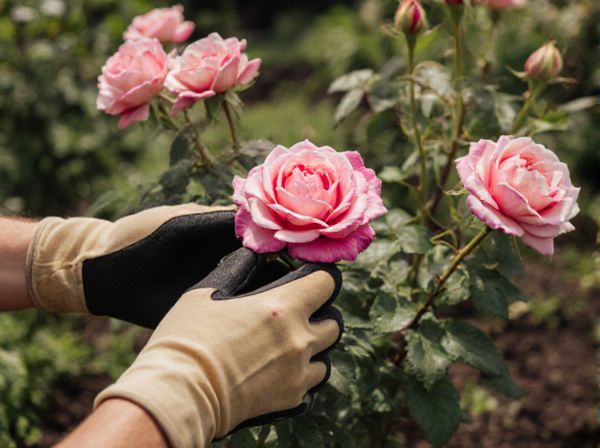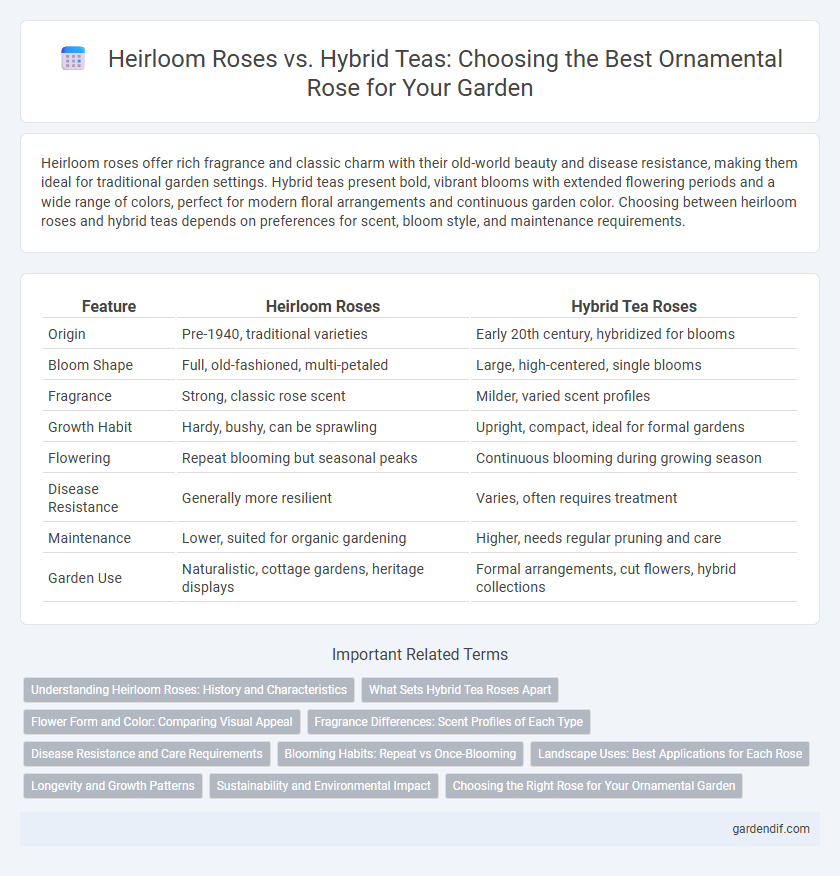
Heirloom Roses vs Hybrid Teas Illustration
Heirloom roses offer rich fragrance and classic charm with their old-world beauty and disease resistance, making them ideal for traditional garden settings. Hybrid teas present bold, vibrant blooms with extended flowering periods and a wide range of colors, perfect for modern floral arrangements and continuous garden color. Choosing between heirloom roses and hybrid teas depends on preferences for scent, bloom style, and maintenance requirements.
Table of Comparison
| Feature | Heirloom Roses | Hybrid Tea Roses |
|---|---|---|
| Origin | Pre-1940, traditional varieties | Early 20th century, hybridized for blooms |
| Bloom Shape | Full, old-fashioned, multi-petaled | Large, high-centered, single blooms |
| Fragrance | Strong, classic rose scent | Milder, varied scent profiles |
| Growth Habit | Hardy, bushy, can be sprawling | Upright, compact, ideal for formal gardens |
| Flowering | Repeat blooming but seasonal peaks | Continuous blooming during growing season |
| Disease Resistance | Generally more resilient | Varies, often requires treatment |
| Maintenance | Lower, suited for organic gardening | Higher, needs regular pruning and care |
| Garden Use | Naturalistic, cottage gardens, heritage displays | Formal arrangements, cut flowers, hybrid collections |
Understanding Heirloom Roses: History and Characteristics
Heirloom roses, also known as old garden roses, date back before 1867 and are prized for their historical significance and fragrant blooms. These roses often exhibit complex petal structures, strong fragrances, and a wide range of colors, reflecting their traditional breeding methods. Unlike hybrid teas, heirloom roses typically display greater disease resistance and a robust, bushy growth habit.
What Sets Hybrid Tea Roses Apart
Hybrid Tea roses distinguish themselves through their large, high-centered blooms and long, sturdy stems, making them ideal for cutting and floral arrangements. Unlike heirloom roses, Hybrid Teas offer a more extensive color palette and repeat blooming cycles throughout the growing season. Their carefully bred fragrance and refined petal formation enhance both garden aesthetics and commercial appeal.
Flower Form and Color: Comparing Visual Appeal
Heirloom roses display a diverse range of flower forms, often featuring full, rosette-shaped blooms with richly textured petals that evoke a vintage charm, while hybrid teas present more classic, high-centered blossoms prized for their elegant symmetry. The color palette of heirloom roses tends to include soft pastels and unique, complex shades with subtle variations, contrasting with hybrid teas, which offer vivid, bold colors and striking bi-colors designed for maximum visual impact. This contrast in flower form and color influences garden aesthetics, with heirloom roses creating nostalgic, natural displays and hybrid teas contributing refined, dramatic focal points.
Fragrance Differences: Scent Profiles of Each Type
Heirloom roses produce rich, complex fragrances often described as fruity, spicy, or classic rose scents, while hybrid tea roses typically exhibit stronger, more singular rose or citrus notes. The scent intensity in heirloom varieties tends to be more pronounced and layered due to their heritage genetics and natural pollination. Hybrid teas, bred for aesthetic appeal and bloom size, may sacrifice some aromatic depth but offer a consistent and oftentimes sweeter fragrance profile favored in modern gardens.
Disease Resistance and Care Requirements
Heirloom roses generally exhibit stronger disease resistance compared to hybrid teas, making them a preferred choice for gardeners seeking low-maintenance ornamental plants. Hybrid tea roses require more attentive care, including regular pruning, fertilization, and vigilant monitoring for common diseases like black spot and powdery mildew. Selecting heirloom varieties can reduce the need for chemical treatments and intensive upkeep, enhancing sustainable garden practices.
Blooming Habits: Repeat vs Once-Blooming
Heirloom roses typically exhibit once-blooming habits, producing a single, abundant flush of flowers in late spring or early summer, which creates a striking seasonal display. In contrast, hybrid tea roses are renowned for their repeat blooming throughout the growing season, offering continuous, fresh blooms from spring until frost. This repeat flowering characteristic makes hybrid teas ideal for gardeners seeking sustained ornamental color and fragrance in their landscapes.
Landscape Uses: Best Applications for Each Rose
Heirloom roses, known for their rich fragrance and disease resistance, are ideal for naturalistic garden borders and cottage-style landscapes where their bushy growth and repeated blooming enhance charm and biodiversity. Hybrid tea roses, prized for their large, elegant blooms and upright form, excel in formal gardens, solitary specimen plantings, and as striking focal points in manicured beds. Selecting heirloom roses fosters a rustic, timeless appeal while hybrid teas contribute structural elegance and refined seasonal color in ornamental landscapes.
Longevity and Growth Patterns
Heirloom roses exhibit exceptional longevity, often thriving for decades with minimal maintenance, making them ideal for sustainable ornamental gardens. Their growth patterns tend to be more vigorous and sprawling, showcasing natural, fragrant blooms that attract pollinators. In contrast, hybrid tea roses offer more controlled, upright growth and frequent blooms but generally require more intensive care to maintain longevity and disease resistance.
Sustainability and Environmental Impact
Heirloom roses offer greater sustainability due to their natural resistance to pests and diseases, reducing the need for chemical pesticides and fertilizers. Hybrid teas, often bred for unique colors and larger blooms, typically require intensive maintenance and higher resource input, increasing their environmental footprint. Choosing heirloom varieties supports biodiversity and soil health, promoting a more eco-friendly ornamental garden.
Choosing the Right Rose for Your Ornamental Garden
Heirloom roses offer rich fragrances and historical charm, thriving in diverse climates with lower maintenance. Hybrid teas provide vibrant blooms and repeat flowering, ideal for structured garden designs and cut flower use. Selecting the right rose depends on your garden's aesthetic goals, climate suitability, and care preferences.
Heirloom Roses vs Hybrid Teas Infographic

 gardendif.com
gardendif.com